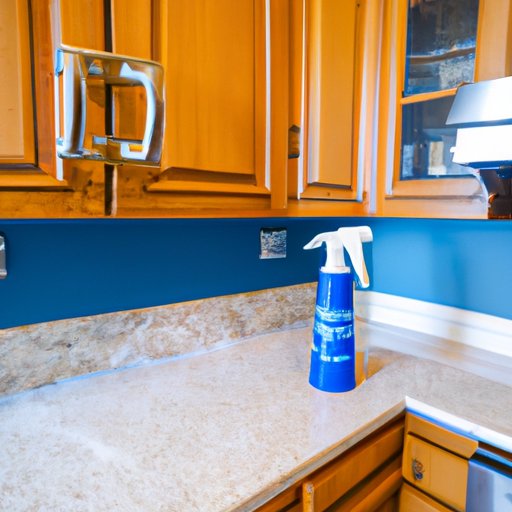Introduction
Cleaning kitchen cabinets can seem like a daunting task, but with the right steps and supplies, it can be done quickly and effectively. A clean kitchen cabinet will make your kitchen look more inviting, and it can also help prevent pests and mold growth. In this article, we will provide a detailed step-by-step guide on how to clean kitchen cabinets.
Wipe Down with a Damp Cloth and All-Purpose Cleaner
The first step in cleaning kitchen cabinets is to wipe them down with a damp cloth and all-purpose cleaner. Start by wiping down the outside of the cabinets with a damp cloth. Be sure to get into the corners and crevices. Then spray the all-purpose cleaner onto the cloth and wipe down the cabinets again. Be careful not to use too much cleaner, as this can cause streaks and residue.
Safety Tips: Wear gloves when using cleaners, and make sure you are in a well-ventilated area. If you are using a chemical cleaner, follow the instructions on the label carefully.
Potential Problems to Avoid: Some wood surfaces may be sensitive to certain cleaners, so test a small area before cleaning the entire cabinet. Also, be sure to rinse off any residual cleaner after cleaning.
Vacuum Out the Dust
Once you have wiped down the cabinets, it’s time to vacuum out any accumulated dust and grime. Use a soft brush attachment to gently remove the dust from the inside and outside of the cabinets. Be sure to reach into the corners and crevices. You may need to repeat this process several times to make sure all the dust has been removed.
Safety Tips: Wear a dust mask when vacuuming, and be sure to empty the vacuum bag or canister after each use.
Potential Problems to Avoid: Do not use a harsh brush attachment as this could scratch the surface of the cabinets. Also, be careful not to push too hard when vacuuming, as this could damage the cabinet.

Use Baking Soda to Remove Grease and Grime
Baking soda is an effective and natural cleaner for kitchen cabinets. To use baking soda, mix it with a few drops of water to create a paste. Apply the paste to the cabinets and let it sit for 10-15 minutes. Then, use a damp cloth to wipe away the paste. The baking soda will absorb the grease and grime, leaving the cabinets clean and fresh.
Safety Tips: Wear gloves when handling baking soda, and be sure to keep it away from children and pets.
Potential Problems to Avoid: Do not use baking soda on painted or laminated cabinets, as it can damage the finish. Also, be sure to rinse off any residual baking soda after cleaning.

Wash Cabinet Shelves in the Sink
If your kitchen cabinets have shelves that are removable, then you can wash them in the sink. Fill the sink with warm water and a mild dish soap, and then place the shelves in the water. Use a sponge or brush to scrub the shelves clean. Once they are clean, rinse them with clean water and let them air dry.
Safety Tips: Make sure the shelves are securely placed in the sink before scrubbing. Also, wear rubber gloves to protect your hands.
Potential Problems to Avoid: Some shelves may be too large to fit in the sink, so you may need to clean them in another way. Also, be sure to dry the shelves completely before putting them back in the cabinets.
Apply a Protective Finish to Keep Cabinets Clean Longer
Once your kitchen cabinets are clean, you can apply a protective finish to keep them looking their best. Choose a finish that is suitable for the material of your cabinets. For example, if your cabinets are made of wood, then choose a wood polish or wax. If your cabinets are made of metal, then choose a metal polish. Apply the finish according to the instructions on the label.
Safety Tips: Wear gloves when applying the finish, and make sure you are in a well-ventilated area.
Potential Problems to Avoid: Some finishes can be difficult to apply, so be sure to follow the instructions carefully. Also, some finishes may take longer to dry than others, so be sure to read the label for drying time.
Conclusion
Cleaning kitchen cabinets doesn’t have to be a daunting task. With the right steps and supplies, you can easily and effectively clean your kitchen cabinets. Start by wiping down the cabinets with a damp cloth and all-purpose cleaner. Then vacuum out the dust, and use baking soda to remove grease and grime. Finally, apply a protective finish to keep the cabinets looking their best. By following these steps, you can have clean and inviting kitchen cabinets in no time.
Benefits of Cleaning Kitchen Cabinets: Clean kitchen cabinets will make your kitchen look more inviting and can also help prevent pests and mold growth. They can also help extend the life of your cabinets by protecting them from dirt and grime.


